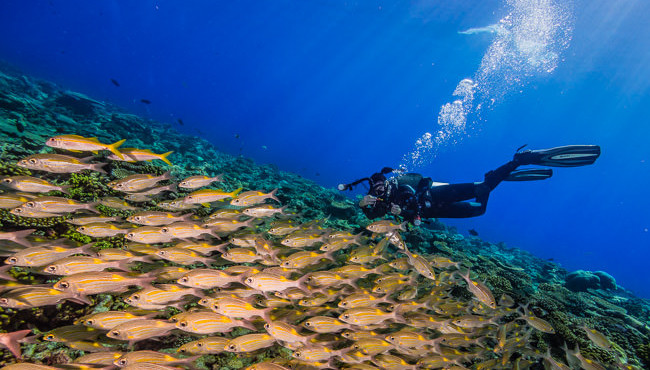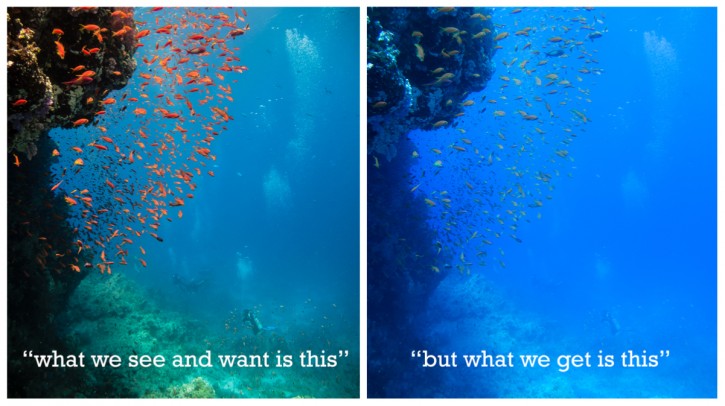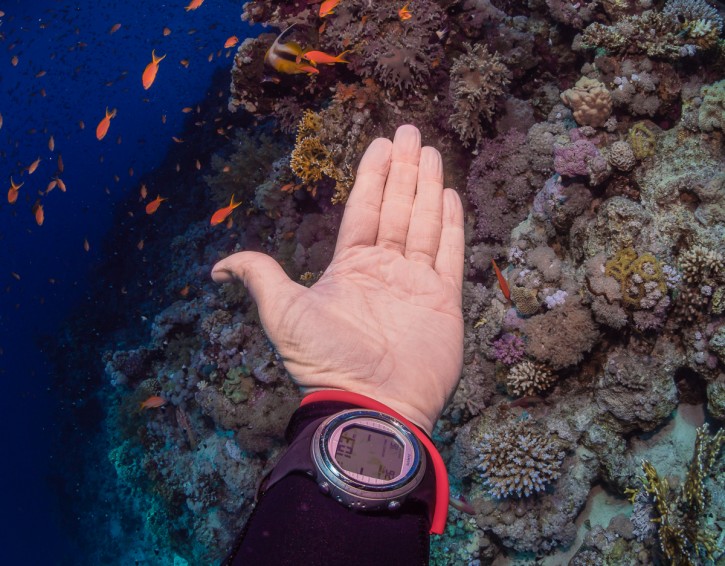News
Duxy’s Underwater Photography Blog: Available Light, Part 2

Why so blue?
In part one of our series on Available Light, I looked at why wide angle lenses are such a deal breaker when trying to get great available light in underwater pictures.
Wide angle lenses are only part of the solution though, and a two pronged assault on the flat, blue problem pictures is what is needed.
We’ve established how you need to get much closer to your subject hence the wide angle lens, but we also need to address the lack of colour that will blight a lot of underwater shots.
We see a multicoloured vibrant reef, resplendent with hard and soft corals, populated by a variety of fish in a myriad of hues. Yet why do our pictures end up as just fifty shades of blue?

Our perception of what we are seeing is one of the main issues in available light underwater photography. So using Custom White Balance allows us to take back control of the situation.
What’s going on?
It helps if we understand a little of what is happening. As we descend the colours are filtered out progressively more as we leave the surface, with the reds and oranges disappearing first followed by the yellows then greens as we approach the relatively modest depths of 15 to 20 metres.
In our minds eyes though, especially nearer to the surface, we “experience” these colours because our brains are tricking us a little. Our cameras though see things as they really are, which is why folk are often disappointed with their first foray into underwater photography.
Pre-digital cameras, we had little alternative than to use strobes or flashguns to replace the colours in our shots.
With the advent of digital though came a new option to control the colour temperature in our pictures, and for each and every shot if we wished.
This opened the door to a whole load of exciting new possibilities for us underwater photographers, and this was called Custom or Manual White Balance.
Setting the right balance
Most digital cameras these days have an option to control the colours of their end results. This is accessed using the menu controls, and is normally a bunch of symbols under the heading of white balance. It’s very difficult to be specific here, as each brand, and even individual models of camera, are often different in this respect. If you’re not sure with your camera, or are thinking of buying a suitable camera once again, get in touch at duxy@scubatravel.com and I will advise you on the current choices.
With beginners this is the single most popular thing I start folk off with on our photo workshops.
When you find the White Balance menu on your particular camera you need to find the symbol in the middle. After accessing it your camera will tell you what to do onscreen. I can’t be more specific because it differs widely from camera to camera.
It’s usually the turning point when they realise that they are able to get great colourful underwater pictures. Here’s a selection of white balanced photos and videos that I shot with compact cameras from across the years:
https://www.youtube.com/watch?v=_V9UUQTSDpk
OK, hopefully that’s shown you that this is a valid technique for putting some colours back in your pictures.
How to do this is the big question though.
As I mentioned, most cameras are very specific with their means to correctly White Balance, but generally speaking the procedure requires you to show the camera a reference “white”. This can actually be a neutral mid grey tone too – a slate is one solution.
Or I tend to just use my hand (see below). You don’t need to fill the whole frame with your hand; better still to hold it at around the distance your foreground interest will be.

This is the usual distance and size in the frame of my hand when taking a white balance reading. I try and replicate the angle and depth at which I am shooting as accurately as possible too.
Follow and read your instruction book
And then you nearly always follow some onscreen instructions to take the reading.
What is clever here is that the camera will try and bring back the neutral mid grey or white back to what it should be, and hopefully then any colour cast, i.e. the blue of the water, will stop affecting the colours in your shots.
As you go deeper you need to take further readings, as the depth that you are at effects the white balance quite markedly.
Distance from subject is also an issue, so it helps to factor in this when you take the reading.
OK – if you follow this procedure in an ideal world and with the conditions in your favour, you’ll get great colourful pictures. Unfortunately we don’t live in a perfect world, and Custom White Balance doesn’t always provide such a simple solution.
So in the next instalment of this four part series we’ll look at some of the pitfalls to Custom White Balance, and in what circumstances it works best, and more importantly what circumstances it doesn’t work too well with.
[hr style=”single”]
 Duxy is the in house photo-pro for UK-based dive tour operator Scuba Travel. To find out about availability on Scuba Travel’s underwater photography workshops hosted by Duxy click here.
Duxy is the in house photo-pro for UK-based dive tour operator Scuba Travel. To find out about availability on Scuba Travel’s underwater photography workshops hosted by Duxy click here.
Gear News
Introducing the TR-80, IR-50 and CS-30 Regulators from DYNAMICNORD

Whether you are a beginner or a professional diver – with the three new main regulators from DYNAMICNORD, everyone will find their favourite regulator. They all look super stylish.
Excellent performance with the TR-80
Quality and performance are the be-all and end-all for regulators. It is not for nothing that the TR stands for Tec Reg. The innovative design of the TR-80 guarantees absolute reliability – even in ice-cold waters.

Perfect breathing effort at 0.8 J/l / certified for diving in waters below 10 degrees / structural design made of solid brass for best cold protection / membrane-compensated design with dry seal of the first stage / reduced exhalation effort thanks to optimized exhalation membrane and bubble deflector / adjustable Venturi (dive/predive) and adjustment knob for individual inhalation comfort / innovative design of the front cover prevents free-flow in strong currents or when diving with scooters / design made of sandblasted brass, matt chrome finish / 2 HP and 4 LP outlets / mouthpiece made of high-quality, anti-allergic silicone for maximum comfort.


Amazing underwater adventures with the IR-50
The IR-50 is the top regulator for advanced and experienced divers. Natural breathing is the essence of this regulator.

Ideal breathing effort at 0.8 J/l /certified for diving in waters below 10 degrees / compensated membrane / adjustable venturi (dive/predive) and adjustment knob for individual inhalation comfort/ outlet valve and deflector for minimum exhalation effort and reduction of bubbles on the face / design made of sandblasted brass, matt chrome finish / 2 HP and 4 NP outlets / mouthpiece made of high-quality, anti-allergic silicone for maximum comfort.


The Workhorse – our CS-30
For diving centres and diving beginners – the workhorse stands for strong construction, reliability and robustness. Perfect for your training.

Optimal breathing effort at 0.8 J/l /recommended for diving in waters above 10 degrees / non-compensated piston / adjustable venturi (dive/predive) / outlet valve and deflector for minimum exhalation effort and reduction of bubbles on the face / design made of sandblasted brass, matt chrome finish / 1 HP and 3 NP outlets / mouthpiece made of high-quality, anti-allergic silicone for maximum comfort.


Octopus OP-30
The OP-30 is the ideal addition to all DYNAMICNORD regulators. It is identical in construction to the CS-30.

The TR-80, IR-50, CS-30 (DIN & INT) regulators and the Octopus OP-30 are available from DYNAMICNORD dealers and in the online store.
DYNAMICNORD – Your Outdoor Companion.
Marine Life & Conservation
Paul Watson Released as Denmark Blocks Japan’s Extradition Bid

Renowned anti-whaling activist Paul Watson has been released from custody in Greenland after spending five months in detention. Denmark’s Justice Ministry rejected Japan’s request for his extradition, citing insufficient guarantees that his time already served in custody would be credited against any potential sentence.
The 74-year-old Canadian-American was arrested on July 21 in Nuuk, Greenland’s capital, when his ship docked to refuel. His arrest was based on a 2012 Japanese warrant related to a 2010 encounter in Antarctic waters. Japan alleged Watson obstructed operations and caused damage to a whaling research ship during efforts to disrupt illegal whaling. Watson has consistently denied these claims, maintaining his commitment to marine conservation.
Denmark, which oversees extradition matters for Greenland, concluded that while the legal conditions for extradition were met, the lack of assurances from Japan regarding time-served credit made extradition untenable.
In a video shared by his foundation, Watson expressed gratitude and relief, saying, “After five months, it’s good to be out… and good to know they’re not sending me to Japan.” He added that the most difficult part of his time in custody was being separated from his two young sons.
Watson is a pioneering figure in marine conservation, known for founding the Captain Paul Watson Foundation in 2022 after decades of activism with the Sea Shepherd Conservation Society. His bold efforts to defend marine life have earned him widespread support, including from celebrities and conservationists. His work has also been featured in the acclaimed reality TV series Whale Wars.
Watson’s lawyer, Jonas Christoffersen, praised the decision, stating, “We are happy and relieved that Paul Watson is now free.” He added that Watson is eager to reunite with his family and continue his vital work.
The arrest occurred while Watson’s vessel, the M/Y John Paul DeJoria, was en route to the North Pacific with a team of 26 volunteers to intercept a Japanese whaling ship. His foundation described the arrest as politically motivated and emphasized that Watson’s actions were focused on ending illegal whaling practices.
Japan resumed commercial whaling in 2019 after leaving the International Whaling Commission, asserting that whale meat is a cultural tradition. Conservationists, however, continue to challenge these practices, highlighting their impact on marine ecosystems.
Despite the challenges, Watson remains steadfast in his mission to protect marine life and bring attention to whaling practices. His dedication to ocean conservation has made him a globally respected advocate for the environment.
-

 News2 months ago
News2 months agoIconic SS United States to become the World’s Largest Artificial Reef
-

 News3 months ago
News3 months agoBook Review – 52 Assignments: Underwater Photography
-

 Gear News3 months ago
Gear News3 months agoDYNAMICNORD – New German diving brand enters the British market
-

 News3 months ago
News3 months agoExploring Cenote El Pit: A Diver’s Dream
-

 Gear News3 months ago
Gear News3 months agoTry BARE drysuits (and maybe even win one!) this Friday with Sea & Sea at North West Dive Fest
-

 Marine Life & Conservation3 months ago
Marine Life & Conservation3 months agoBook Review: Coral Triangle Cameos
-

 Blogs2 months ago
Blogs2 months agoDive the Egyptian Red Sea this Autumn with Regaldive
-

 News3 months ago
News3 months ago2024 Ocean Art Underwater Photo Competition Announced















